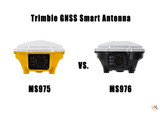Shop Now: https://www.4kequipment.com/trimble-machine-control/
The Trimble MS975 and MS976 are both GNSS smart antennas designed for high-accuracy positioning, typically used in construction and civil engineering applications. Here are the primary differences between these two models:
Number of GNSS Channels:
- Trimble MS975: Has fewer GNSS channels than the MS976, which may limit performance slightly in certain conditions but is still highly effective for most construction applications.
- Trimble MS976: Typically features more GNSS channels compared to the MS975, allowing it to track more satellite signals simultaneously, improving the accuracy and reliability of the positioning data, especially in challenging environments.
Antenna Technology:
- Trimble MS975: Uses robust antenna technology suitable for various applications but might be less adept at handling severe signal disruptions.
- Trimble MS976: May incorporate more advanced antenna technology, enhancing its ability to maintain signal lock in environments with obstructions such as trees or buildings.
Integrated Technology:
- Trimble MS975: Focuses on providing robust and reliable GNSS data suitable for general construction needs without the extras that might be included in the MS976.
- Trimble MS976: Could possibly include additional integrated technologies like advanced filtering and corrections for greater precision, tailored for more complex projects and environments.
Use Cases:
- Trimble MS975: Best suited for general construction tasks where high accuracy is needed but the environment is less challenging, making it a cost-effective choice for a wide range of projects.
- Trimble MS976: Because of its enhanced capabilities, it is ideal for large-scale and complex projects that require the highest level of accuracy and reliability under challenging conditions.
Cost:
- Trimble MS975: Generally more affordable, making it a popular choice for projects with budget constraints.
- Trimble MS976: Likely to be more expensive due to its advanced features and capabilities.
These differences make each model suitable for specific types of projects based on the environmental conditions, the required accuracy level, and budget considerations.

